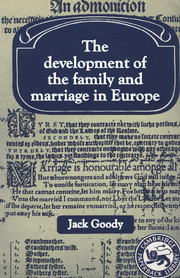Book contents
- Frontmatter
- Contents
- List of figures, maps and tables
- Preface
- 1 Perspectives
- 2 Two sides to the Mediterranean
- 3 Change in the German lands
- 4 Cousins and widows, adoptees and concubines
- 5 From sect to Church
- 6 Church, land and family in the West
- 7 Reformation and reform
- 8 The hidden economy of kinship
- 9 The spiritual and the natural
- Appendix 1 Kin groups: clans, lineages and lignages
- Appendix 2 From brideprice to dowry?
- Appendix 3 ‘Bilaterality’ and the development of English kin terminology
- References and bibliography
- Glossary
- Index
2 - Two sides to the Mediterranean
Published online by Cambridge University Press: 05 June 2012
- Frontmatter
- Contents
- List of figures, maps and tables
- Preface
- 1 Perspectives
- 2 Two sides to the Mediterranean
- 3 Change in the German lands
- 4 Cousins and widows, adoptees and concubines
- 5 From sect to Church
- 6 Church, land and family in the West
- 7 Reformation and reform
- 8 The hidden economy of kinship
- 9 The spiritual and the natural
- Appendix 1 Kin groups: clans, lineages and lignages
- Appendix 2 From brideprice to dowry?
- Appendix 3 ‘Bilaterality’ and the development of English kin terminology
- References and bibliography
- Glossary
- Index
Summary
From the vantage point of a broad, geopolitical approach to history, the unity of the Mediterranean world is an obvious fact of life. The French historian, Fernand Braudel, has stressed how the lives of its inhabitants from different countries were influenced by the problems and advantages posed by their common frontier on the inland sea, especially their shared experiences of changes in climate and in population, and their joint involvement in trade and warfare. But there was also diversity, consisting not simply of small differences but of broad oppositions. A recent historical study of the Spanish-African frontier insists that ‘the separation of the Mediterranean world into different, well-defined cultural spheres is the main theme of its sixteenth-century history’ (Hess 1978: 3); Latin Christian culture had always been opposed to Turko-Muslim civilisation throughout the Middle Ages, but now the opposition increased as the Crescent was surrounded by the Cross with its superiority of ship and gun.
The question of whether the emphasis should be placed on diversity or unity impinges very directly on the spheres of family, kinship and marriage. To some writers, especially from a northern viewpoint, the systems that obtain on the European and African shores now and in the past, seem to differ very radically. Yet others, stimulated not only by the works of Braudel but by the growing interest in ‘Mediterranean studies’, have been impressed by the common features in the daily life of the inhabitants of the two shores of the sea.
- Type
- Chapter
- Information
- The Development of the Family and Marriage in Europe , pp. 6 - 33Publisher: Cambridge University PressPrint publication year: 1983

